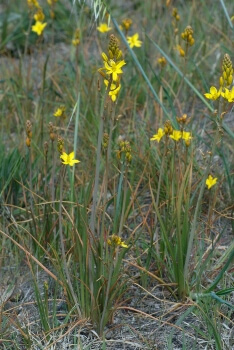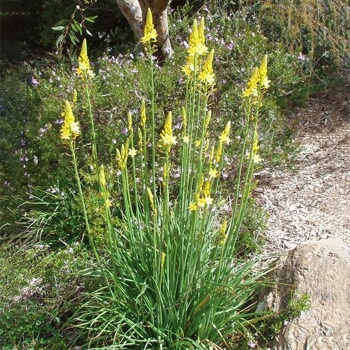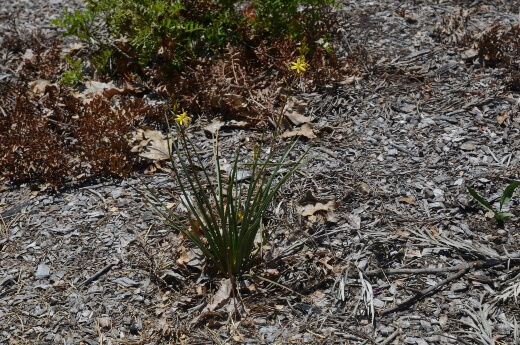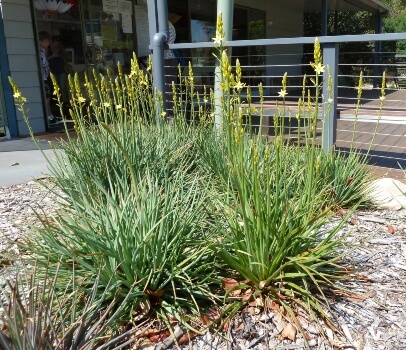Bulbine bulbosa is one of our more unique bush tucker plants. It is a clumping perennial that grows in dense tufts featuring tapered cylindrical leaves, buttery-yellow star-like blooms and a bulb-like tuber, known as a corm, which is edible.
It is a great native alternative for daffodils and I truly appreciate the ornamental influence this lovely plant can add to gardens. In this article, I will be sharing everything you need to know to grow and care for this quirky bush tucker, as well as outlining how you can take advantage of its nutritious rootstock.
More...

Family: | Asphodelaceae |
|---|---|
Genus: | Bulbine |
Species: | B. bulbosa |
Common Names: | Bulbine lily, native leek, golden lily |
Origin: | Australian Native |
Location: | Outdoor |
Type: | Flowering plant |
Growth: | 40 to 80 centimetres tall, 30 to 50 centimetres wide |
Sun requirements: | Full sun to light shade |
Foliage Colour: | Green |
Flower Colour: | Yellow |
Flowering: | Spring to autumn |
Fruit: | Corm and attached roots are edible |
Maintenance level: | Low |
Poisonous for pets: | All parts are toxic to cats and dogs |
Getting to Know Bulbine bulbosa
Not only are the 6-petalled, bright-yellow blooms highly decorative, but they also feature a wonderful fragrance within gardens. The grass-like foliage forms upright with stems adorned with long-lasting blooms from spring through to autumn.
This cheery garden ornamental is easy to enjoy and offers fantastic landscaping applications.
Endemic to Australia, this plant naturally occurs from Queensland through to Tasmania, growing in a wide range of habits and soils in most states except Western Australia and the Northern Territory.
Botanically labelled Bulbine bulbosa, common names now include bulbine lily, native leek and golden lily. It can grow in many of our endemic climates including subtropical, temperate, and Mediterranean. It is also suitable for cooler regions.
Common uses include:
- Garden flower
- Excellent in rockeries
- Cottage gardens
- Container gardening
- Gap-filling
- Clustered growth in larger spaces
How to Grow Bulbine bulbosa
This rhizomatous plant can be propagated using seeds or by division of the corm. Though it may be a little difficult to find nurseries that stock this species, some will. Nursery plants are easy to establish and will bloom far sooner.
Growing Native Leek from Seeds
- Collect seeds from ripened seed capsules after flowering.
- Keep them dormant for 2 to 3 months before use. Use within 1 year.
- Seeds are ready once they’ve turned from cream to grey-brown.
- Surface sow seeds in autumn into containers prepared with a quality seed-raising mix or potting soil.
- Lightly mist the seeds after sowing then keep them in a cool, sheltered location.
- The ideal temperature for germination is around 16°C.
- Germination should occur within 4 to 8 weeks.
Propagating Golden Lily using Division
- Gently lift the plant from the ground, exposing the corms and attached roots.
- Using a sharp and sterilised trowel, swiftly cut a clump of corm and roots from the plant with some leaves attached as well.
- Repot the newly divided plant into fresh potting soil and water lightly.
- Keep in a temperate and sheltered location.
Planting and Growing Conditions for Bulbine bulbosa
This beautiful species can brighten up your garden from spring right through to early autumn with its brilliant buttery blooms. Early spring or autumn are the best times of the year to plant when temperatures are not too hostile.
Best Soil
Good drainage and moisture are essential for this species to thrive. While it can tolerate a variety of soil types, it does prefer loamy soil or sandy loam soil that holds lots of water. Poorer soils can be boosted by mixing in some well-rotted materials and compost before planting.
Sunlight Needs
Choose a planting site that receives full sun to light, dappled shade. Full sun is preferable for cooler regions whereas light shade is ideal for warmer areas.
Tips for Growing in Pots
Container-grown plants should still get the right amount of light each day, full sun to light shade. Use a quality potting mix and water regularly. Be sure you are also using a container with good drainage. Prune off old or dying stems as needed to maintain the appearance and promote new growth.
(If you don’t have one yet or in need of a replacement, check out our review of the best pruning shears for 2023.)


Get Your Free Guide:
Master Growing Australian Natives eBook
A Must Have Complete Guide for Every Australian Garden
Get Your Free Guide:
Master Growing Australian Natives eBook
A Must Have Complete Guide for Every Australian Garden
Caring for Bulbine bulbosa
Once established, bulbine lily is tolerant to frosts but sensitive to drought. Here are a few essential care tips to keep your plant healthy and thriving.

Source: Provincial Plants & Landscapes
Watering Bulbine bulbosa
This species requires regular watering throughout the year to keep it moist. It can die back in the hotter, drier periods of the year but with regular water, new growth can be continually produced. On average, water deeply every week and adjust as needed from there.
Pruning Native Leek
Prune after flowering in late summer to remove spent flower clusters and trim away older leaves to maintain appearance. Lightly prune in spring to encourage new growth during the active growing seasons.
Fertiliser Needs
Feed your plant in spring with small quantities of quality native plant food to encourage growth and longer flowering.
Mulching
In most conditions, mulching shouldn’t be necessary. However, if you are struggling with maintaining adequate moisture levels, you can add a layer of organic mulch like pine bark or grass clipping around the base of the plant in summer to assist with retaining more moisture.
Bulbine bulbosa Bush Tucker Guide
This plant grows from corms beneath the ground. The corms as well as the attached roots around the corms of mature plants are edible. Traditionally, this plant has been sought-after for generations by Aboriginal people as a nutritious source of bushfood.
These globose tubers can take years to mature but they are well worth the wait. The corms of Bulbine bulbosa are considered some of the sweetest-tasting tucker of all Australian lilies and lily-like species.

Source: The Jungle Collective
Harvesting Native Leek
- Once the leaves have died back in mid to late summer, the corm beneath the ground should be ready for harvest.
- Gently dig up the plant using a spade, shovel or trowel to expose the corm and attached roots.
- Choose the largest pieces of the corm to detach and keep for consumption.
- Place the plant back in the ground and the rest of the corm will resprout the following autumn.
- Corms from mature plants can be collected and consumed all year round.
How to Use Bulbine bulbosa Tubers
- As mentioned, the underground corm and the attached roots are edible.
- It is best to roast the corm and roots to produce the best taste.
- They can also be steamed.
- Be sure to rinse the produce before use.
- The corms have a sweet taste with a starchy texture.
- The roots have a mild oniony flavour.
- These parts are highly nutritious and contain lots of calcium and iron.
Bulbine bulbosa Pests and Diseases
This species is generally disease-free. There are however some pests that can become an issue.
Aphids
Aphids are small sap-sucking insects that are very common garden pests. There are thousands of species in Australia and many ways to treat affected plants. Follow our guide below for everything you need to know about identifying and controlling aphids.
Snails and Slugs
In some environments, garden snails and slugs may enjoy eating the foliage of bulbine lilies. While this may not be deadly, it can cause your plant to look weathered and wilted.
These pests usually attack at night so control can be a little tricky. The best way to get rid of them is to remove them by hand and place them off the premises or set snail and slug traps around your plants.
Alternatively, some pesticides do specifically target snails and slugs but we always recommend using organic pest control approaches as much as possible. A physical barrier can also certainly help.
Bulbine bulbosa Frequently Asked Questions

Source: Paten Park Native Nursery
What is the Bulbine bulbosa used for?
This Australian native is useful as a food plant and ornamental garden flower. The plump and round corms are best enjoyed after roasting where they feature a sweet and starchy flavour.
What are the roots of a bulbine lily?
The bulbous tuberous rootstock is known as a corm. Plants die off to these roots in summer when they can be harvested for consumption. These roots are considered some of the sweetest of all lily roots.
What does Bulbine bulbosa attract?
These clumping perennials are great for attracting bees, butterflies and native birds to the garden using their brilliantly yellow and fragrant blooms.
Can you divide Bulbine bulbosa?
Yes, established plants respond well to being propagated using division of the underground rhizomes. Once the grass-like clumps get big enough, you can divide them into separate plants to grow your collection from home.
How many bulbine species are there?
The bulbine genus consists of about 50 species that are found in South Africa and Australia. Australia has about 5 endemic species.
Should you cut back Bulbine bulbosa?
These plants can become quite leggy and will respond well to periodic grooming. Prune faded flower clusters to promote more blooms and trim down foliage lightly in spring to remove cold damage.
How tall is a mature bulbine?
The mature height of this plant is around 60 cm to 80 cm depending on the growing conditions.
Interested in learning more about some of our other native bush tucker lilies? Be sure to refer to some of our informative guides below for more:
Wrapping Up Our Bulbine bulbosa Guide
There’s a lot to love about Bulbine bulbosa. This quirky bush tucker not only produces nutritious rootstocks but can also provide gardens with long-lasting flushes of bright-yellow fragrant blooms from spring to autumn.
If you’re like me and adore the more unusual species Australia has to offer, this plant is an easy pick. Whether grown for its buttery blooms or clumping habit, it can offer many useful landscaping applications in most Australian gardens, regardless of size.
Start enjoying the charming Bulbine bulbosa today.
Published on April 26, 2023 by Lorri Hopkins
Last Updated on January 19, 2025





